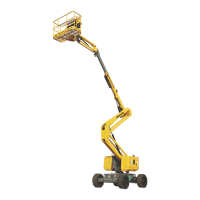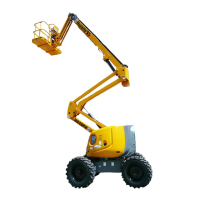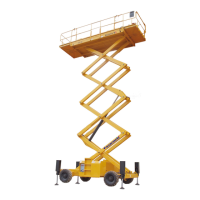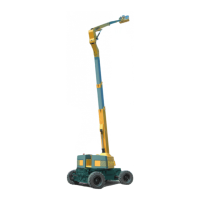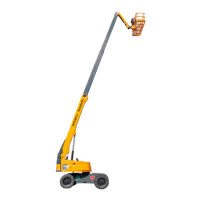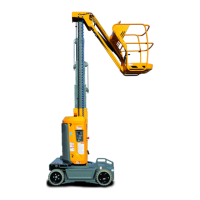Do you have a question about the Haulotte HB135JRT and is the answer not in the manual?
General safety instructions and conditions to avoid when operating the machine.
Key prohibitions to ensure safe machine operation and prevent accidents.
Identifies and explains potential risks associated with machine operation.
Provides instructions to prevent falling from the platform during operation.
Explains electrocution risks and minimum safe distances from power lines.
Addresses risks of movement issues and overturning, including surface checks.
Details risks associated with burns and explosions, particularly related to batteries and fuel.
Explains risks of crushing and collision and safety measures during operation.
Details the operator's duties regarding manual understanding, reporting, and safe operation.
Details the inspection and maintenance schedule and responsibilities of parties.
Description of various safety devices installed on the machine for user protection.
Indicates internal malfunctions and explains downgraded mode.
System that restricts movement if platform load exceeds the authorized limit.
Indicator and system for maintaining the machine within stability limits.
Daily visual inspection and functional tests required before operating the machine.
Procedures for testing safety features and control box operations.
Step-by-step guide for starting and operating the machine from the ground control box.
Step-by-step guide for starting the engine from the ground control box.
Operating boom, jib, and turntable controls from the ground control box.
Step-by-step guide for operating the machine from the platform control box.
Steps to start the engine from the platform control box.
Operating driving, steering, and boom/jib movements from the platform.
Procedure for extending the front axle, including safety warnings.
Procedure for retracting the front and rear axles, including safety warnings.
Steps to place the machine in transport configuration using the positioning box.
Procedure for lowering the platform in emergency situations or when controls are inaccessible.
Step-by-step guide for emergency lowering using ground controls.
Procedure for lowering the operator to the ground in case of main power failure.
Steps to lower the platform using back-up hydraulic system selector.
Steps to prepare the machine for transport, including securing and locking.
Procedure for identifying and responding to internal machine faults detected by the system.
Steps to follow when an internal fault is detected.
Procedure and load table for performing the overload test.
Confirms machine movements, safety systems, and operating speeds.
Proves machine stability in unfavorable positions and calculates tipping moment.
General safety instructions and conditions to avoid when operating the machine.
Key prohibitions to ensure safe machine operation and prevent accidents.
Identifies and explains potential risks associated with machine operation.
Provides instructions to prevent falling from the platform during operation.
Explains electrocution risks and minimum safe distances from power lines.
Addresses risks of movement issues and overturning, including surface checks.
Details risks associated with burns and explosions, particularly related to batteries and fuel.
Explains risks of crushing and collision and safety measures during operation.
Details the operator's duties regarding manual understanding, reporting, and safe operation.
Details the inspection and maintenance schedule and responsibilities of parties.
Description of various safety devices installed on the machine for user protection.
Indicates internal malfunctions and explains downgraded mode.
System that restricts movement if platform load exceeds the authorized limit.
Indicator and system for maintaining the machine within stability limits.
Daily visual inspection and functional tests required before operating the machine.
Procedures for testing safety features and control box operations.
Step-by-step guide for starting and operating the machine from the ground control box.
Step-by-step guide for starting the engine from the ground control box.
Operating boom, jib, and turntable controls from the ground control box.
Step-by-step guide for operating the machine from the platform control box.
Steps to start the engine from the platform control box.
Operating driving, steering, and boom/jib movements from the platform.
Procedure for extending the front axle, including safety warnings.
Procedure for retracting the front and rear axles, including safety warnings.
Steps to place the machine in transport configuration using the positioning box.
Procedure for lowering the platform in emergency situations or when controls are inaccessible.
Step-by-step guide for emergency lowering using ground controls.
Procedure for lowering the operator to the ground in case of main power failure.
Steps to lower the platform using back-up hydraulic system selector.
Steps to prepare the machine for transport, including securing and locking.
Procedure for identifying and responding to internal machine faults detected by the system.
Steps to follow when an internal fault is detected.
Procedure and load table for performing the overload test.
Confirms machine movements, safety systems, and operating speeds.
Proves machine stability in unfavorable positions and calculates tipping moment.
| Maximum Load Capacity | 230 kg |
|---|---|
| Weight | 3, 800 kg |
| Lift Capacity | 230 kg |
| Platform Length | 1.83 m |
| Platform Width | 0.8 m |
| Power Source | Diesel |
| Drive Type | 4WD |
| Horizontal Reach | 6.7 m |
